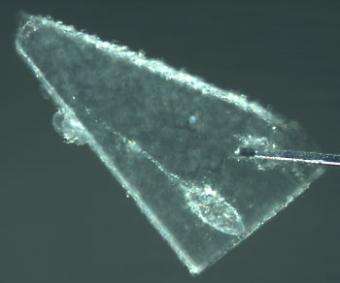Seeing stardust: New image shows speck of comet dust from NASA mission

This photo from NASA shows a mote of comet dust embedded in a tiny wedge of aerogel extracted from the Stardust collectors that returned to Earth Jan. 15. The comet dust was extracted by University of California, Berkeley, researcher Christopher Snead using new nanomanipulation techniques developed at the campus's Space Sciences Laboratory.
The grain of dust entered the aerogel from the lower right at supersonic speed and moved to the upper left, where it can be seen as a bright dot at the end of the carrot-shaped trail. The large oval cavity at lower right was blown out by shock waves created as the grain exceeded the sound barrier in the aerogel. At right is a micromachined fixture developed by UC Berkeley physicists, in collaboration with Chris Keller of MEMS Precision Instruments, to extract grains of comet and interstellar dust from the detectors.
A team led by UC Berkeley research physicist Andrew Westphal also developed the device – a glass needle attached to a robotically-controlled micromanipulator – to cut out the wedge-shaped piece of aerogel from a larger aerogel tile. The aerogel-embedded comet grain, still in the clean room at the Johnson Space Center in Houston, will be distributed to researchers for study. The trail is about 1 millimeter long, while the dust grain is only 10 microns across, or one-tenth the diameter of a human hair.
Source: UC Berkeley

















